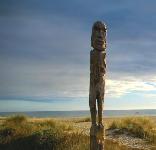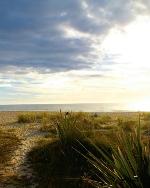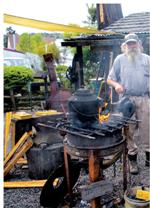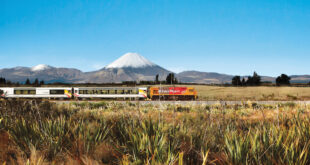STORY AND PHOTOGRAPHS BY ALLAN DICK of NZ Today Magazine
 For the record, this visit to The West Coast started at Murchison — on the Sunday morning after the Wild Food Festival at Hokitika — and it ended at the Gates of Haast on Wednesday afternoon. Murchison was overflowing with people heading back from the Wild Food Festival to wherever it was that they’d come from. The Hokitika event is pretty much a younger person’s weekend and many of those heading home were recreational and hobby motorcyclists and despite the fact that most are marketing managers, or computer programmers in real life and there wasn’t a patch-wearing bikie to be seen, the Police presence was strong with half a dozen marked patrol cars in Murchison, obviously on escort duty.
For the record, this visit to The West Coast started at Murchison — on the Sunday morning after the Wild Food Festival at Hokitika — and it ended at the Gates of Haast on Wednesday afternoon. Murchison was overflowing with people heading back from the Wild Food Festival to wherever it was that they’d come from. The Hokitika event is pretty much a younger person’s weekend and many of those heading home were recreational and hobby motorcyclists and despite the fact that most are marketing managers, or computer programmers in real life and there wasn’t a patch-wearing bikie to be seen, the Police presence was strong with half a dozen marked patrol cars in Murchison, obviously on escort duty.
We were a two car strong team at this time. I’d driven down from Auckland in a Nissan Navara ute with Colin Winks, an old mate from my teenage years and we wallowed in nostalgia over the times when we drove our parents sick with worry as we flirted with being a combination of milky bar cowboys and Teddy Boys back in the late 1950s. We were the editorial team and we met up with Peter van der Harst, NZ Today’s advertising manager in his car on the wharf at Wellington ready to catch the InterIslander 6pm sailing Saturday. We stayed the night in Blenheim and headed out for Murchison via the Waiau Valley in brilliant sunshine and basking warm temperatures.
This was a glorious drive and I tried to formulate a plan of action as we drove. I’d signalled this expedition to the ‘coast through my Saturday morning show on Radio Pacific and had a diary filled with offers of accommodation, meals, cups of tea, visits to various attractions and “call in and say hello”. We set out with the best of intentions to try and accept as many of these offers as possible — not because they were freebies, but because we really wanted to get under the skin of being a ‘coaster. As it turned out we couldn’t accept many of these invitations because the loose plans I put together as we headed for the coast were destroyed when New Zealand was hit by a sudden and unexpected southerly change that brought low cloud, strong winds, rain and snow to low levels. But that was later, this was Sunday and the weather was glorious.
The drive down through Inangahua and the Buller Gorge was sensational, but progress was slow as I insisted on stopping the Navara at every photo opportunity and we arrived in Westport mid-afternoon rather than early afternoon. So many decisions! Should we stay in Westport and head up to Karamea the next day? Should we head up to Karamea now and stay the night? Or should we head up to Karamea and come back that night and stay in Westport? We thought about it as we toured the town, stopping off at the wharf where the Holcim cement ship was being berthed ready to take on board another load for Auckland where it would be turned into flash apartment blocks and tilt-slab industrial units. Westport cement remains one of the biggest industries on the coast, but there’s a serious question mark over its future as Australian based Holcim have already indicated they are considering moving their South Island operations to the outskirts of Oamaru in North Otago. The entire West Coast was dragged into the 20th century with a lot of pain and suffering.
The traditional industries were in trouble. Gold mining petered out, the demand for coal dropped off (there were also huge changes in how coal was mined) and the dairy industry had always been the second-cousin to sheep and cattle farming. Then the final blow — the ending of the logging of native timber. None of this happened all at once, but it was a succession of body blows over a couple of decades that left coasters groggy and the entire region teetering on the brink of economic disaster. And it showed. Visit the West Coast in the area from 1970 to 1990 and it was almost a step into the depressed mountain areas of the Eastern United States — the Ozarks and the Appalachians. And it showed in the big towns like Westport and Greymouth as well as the smaller communities.
But the end of native timber logging came with a multi-million dollar cash settlement from the government that eased the pain, even though generations of living a certain West Coast lifestyle had come to an end. That cash has been invested and is managed to encourage new industries to the coast. But other forces were also at work. The rest of New Zealand discovered The West Coast and tourism has started to shift up through the gears, dairy farming has become the rich-cousin, there’s been a massive international increase in the demand for coal — in the most recent development, gold prices have increased dramatically.
The change in Westport was immediately obvious compared to my last visit. No more shut or marginally operative shops, instead fresh paint on many buildings and just a busier hum about the place, even on a Sunday afternoon.
We decided on plan C, which was to find a place in Westport for the night and strike out on a lightning raid to Karamea and back. Peter found us a motel for the night with the recommendation of a good restaurant for a meal when we got back. But that didn’t take into account my penchant for following my nose, following road signs and stopping to take photographs. If I had really had my way I would have stopped at every one of the numerous and still very traditional small West Coast pubs on the way. I, of course, would have drunk Coke, or Sarsaparilla and soaked up the atmosphere and the local conversation. But, if that had happened, we’d still be getting to Karamea.
We did make some detours — up the hill to Denniston, where I chatted to a couple from Motueka who had just spent a few nights in a lodge up near Mokhinui. They were Denniston devotees and had with them their collector’s edition of the book “Denniston Rose” — the wonderful account of a young woman growing up and living in Denniston when the coal mine was operating and they sent the wagons filled with the black stuff hurtling down the side of the mountain. They were disappointed that the museum in the old Denniston School wasn’t open on such a gorgeous Sunday afternoon. The drive up the coast north of Westport isn’t as spectacular as it is to Greymouth, but it still beats the Canterbury Plains hands down.
 Just before the start of the Karamea Bluff where the flat, straight road goes into convulsions, we tiki-toured up the Mokhinui Valley to Seddonville where Graham McKenzie runs a very tidy little pub — and raises piglets into giant pigs in a small paddock across the road. The other two had big beers, I sipped at a small one and went across the road to look at the pigs —big, gentle, intelligent animals who responded to a little back tickling and ear rubbing. Despite its remoteness, the bar was busy with locals and we let our eyes cruise the walls looking at the rows of historic photographs from around the immediate area.
Just before the start of the Karamea Bluff where the flat, straight road goes into convulsions, we tiki-toured up the Mokhinui Valley to Seddonville where Graham McKenzie runs a very tidy little pub — and raises piglets into giant pigs in a small paddock across the road. The other two had big beers, I sipped at a small one and went across the road to look at the pigs —big, gentle, intelligent animals who responded to a little back tickling and ear rubbing. Despite its remoteness, the bar was busy with locals and we let our eyes cruise the walls looking at the rows of historic photographs from around the immediate area.
The accommodation at the Seddonville pub was full which surprised me, but Meridian Energy are investigating the possibility of a hydrodam further up the valley. Take a look at a map and see what we are talking about here — miles and miles and miles of the Kahurangi National Park. A decade or so ago the Fletcher Group looked at the possibility of a hydro scheme in the Ngakawau area behind Granity a few kilometres south of the Mokhinui, but environmental issues torpedoed this and it disappeared without a trace.
The drive over the Karamea Bluff is sensational, twisting, climbing and plunging, through well-established second growth native bush. Back on the flat and on the last leg to Karamea we spotted an immaculately restored Singer sports car outside the Little Wanganui pub, so we dropped a copy of Classic Driver on the passenger’s seat and pressed on. Contrary to popular opinion the road up the coast doesn’t end abruptly at Karamea — it goes on for another 15 kms or so to a small DoC camping ground and the start of the Heaphy Track.
My Radio Pacific people had told me that this area was well worth a visit — not just because of the Heaphy Track but also because of a spectacular natural arch at Oparata and also a disused sawmill. But time was against us, so we made do with a stop at the very end of the road in a gorgeous setting. There were a couple of campers battling the sandflies that we’d been warned were especially large this year and numerous. So big and so many they blotted out the sun and within seconds of alighting from the Navara my feet, legs, arms and face were black with these vampire creatures, biting and sucking blood.
Luckily, my immune system or whatever it is, protects me from the worst effects of sandfly or mosquito bites but it’s not nice being covered with the things, so I swatted, danced and slapped as I tried to make friends with a Mother Weka who didn’t want me finding her cute chick snuggled into the roots of a flax bush. Then I said “Hello” to camper Tom Bowker who was from the state of Maine in the USA. He was smothered in Dimp and was fresh from a spot of rock-climbing and a visit to the Hokitika Wild Foods Festival — “Wow, that was crazy. It was all on for young and old. Great fun! Never seen anything like it. Beer was the staple diet…” I’d been careless enough to leave the door of the Navara open, so when we got on the road again the air inside the cabin was black with bloody sandflies and we spent the journey back to near Westport swotting the things against the windows — many left blood smears.
The major West Coast tourist trail follows the Lewis Pass into Greymouth with side trips up the coast to Punakaiki and back, before heading south for the glaciers and Haast, leaving Westport north just a bit out of the mainstream tourist action. But what this area does have is a very strong back-packer and adventure tourism industry and this is clearly on display at Karamea with establishments like the impressive The Last Resort, complete with grass growing on the roof of the main block.
It’s often said that The West Coast has its own micro-climate that’s considerably warmer than the rest of the South Island and Karamea is almost sub-tropical with a profusion of Nikau palms that grow almost like weeds. I had promised a Radio Pacific listener I’d call into the Pig and Whistle pub just a little north of Westport and say hello to Pat and Graham. Graham wasn’t there, but Pat was. Lovely little pub painted in a most un-West Coast pink. The sign outside said “Established 1868”, but surely like most small country pubs this was the third or fourth building — “No,” said Pat. “It’s the original, it’s been added onto, but it’s one of the few that’s never been burned down and replaced.
It was originally called The Railway Hotel and it has been here since 1868.” We chatted to a couple of locals — Paul Storer and Maurice Douglas. They’ve been mates since they were kids. Paul’s been a local all of his life and now owns a dairy farm. Maurice went walkabout for a while — “About 20 years,” says Paul. “He decided to have a look around the world and he’s not long back.” Maurice had indeed been around the world — several times — including a longish stint in Kazakhstan. “It was interesting — and a bit dangerous. The people you work with are nice, but the countryside’s full of brigands and robbers. We got tired of the local food and decided to import our own European food. But the convoy of trucks was always shot up and robbed, so we had to continue eating what everyone else did.”
Maurice is now a supervisor “up the hill” — a phrase used for the huge Stockton mine. We inhaled the local atmosphere and then realised that it was after 8 pm and if we didn’t get a wriggle on, we’d have no dinner. We got to the Denniston Dog Restaurant just on 9.00pm. In Auckland, outside places like the Viaduct, at 9.00pm on a Sunday night you are going to be hard pressed to find a place still prepared to serve a meal. And so it was at the Denniston Dog — the kitchen was basically closed, but they supposed they might be able to . . . .
So we went in search of somewhere that was just a little more enthusiastic and found it at the Westport Motor Inn which was pretty much brand new when I stayed there on my first trip to the ‘coast in 1972. They had a Sunday night buffet and were just about to put it all away, but we were welcome to tuck in at a discounted price. The service was outstanding — warm, friendly, couldn’t do enough for us. And the food was certainly OK. The accommodation Peter had found us wasn’t in the actual Palm Court Motel, but in a cottage next door — as some of the party have a reputation for snoring, it was just as well we had three bedrooms . . . The motel’s owned by Robert and Cherylynn Duncan. Robert’s a former deep sea fisherman who’s come ashore to be a motelier. But he’s got a side interest — his huge Honda Goldwing motorbike. “I use it most weekends — like to go for a ride up to Reefton and have a coffee at one of the cafes . . .” Reefton! Cafe? Wasn’t so long ago that Reefton and Cafe in the same sentence would have been an oxymoron.
Apart from the cool reaction at the Denniston Dog, Westport was incredibly friendly. Lyn Taylor at the information centre couldn’t do enough for us and if there are three things we would recommend going to Westport for alone it would be the warmth of the people, the Coal museum and Gibby’s restaurant which is hardly upmarket, but the array of home-made food and baking is incredible and it’s obvious that the local people go there out of choice. I had a whitebait meal there last year and I almost couldn’t eat all of it. The operative word here is “almost”. . . It was raining lightly in the morning so we postponed a four wheel drive trip into the old gold mining settlement at Big River near Reefton until later in the week when everyone was sure the weather would have improved. Colin and I piled into the Navara at this point, leaving Peter to go about his work by himself and we headed to Reefton to have a look at the place anyway.
In all of my previous visits, Reefton has always been down at heel, down on its luck and down-trodden. In the two years since I last had a look at the place it’s been transformed, as Reefton has grabbed the opportunities of the new era and made the most of them. It’s been helped a bit with the re-opening of the gold mine late last year by Australian company Oceania, but the reversal of fortunes started before that.
 Reefton, the first town in the Southern Hemisphere to have a public supply of electricity, is humming. It now has cafes where there were once near derelict shops. There’s a flash bakery that wouldn’t be out of place in Ponsonby. The change has come in the nick of time to save the precious heritage of the town. Many of the changes have come from locals who have a vision — like Tracy Hampton who has opened a craft and gift shop in what was originally “Millers”, the only draper on The West Coast and then a grocery Keystore, but more latterly just plain empty. Or the four retired blokes who dress up like miners of last century and man the replica miner’s cottage on the main street day in and day out, just for the love of it.
Reefton, the first town in the Southern Hemisphere to have a public supply of electricity, is humming. It now has cafes where there were once near derelict shops. There’s a flash bakery that wouldn’t be out of place in Ponsonby. The change has come in the nick of time to save the precious heritage of the town. Many of the changes have come from locals who have a vision — like Tracy Hampton who has opened a craft and gift shop in what was originally “Millers”, the only draper on The West Coast and then a grocery Keystore, but more latterly just plain empty. Or the four retired blokes who dress up like miners of last century and man the replica miner’s cottage on the main street day in and day out, just for the love of it.
But there are also newcomers — like retired Rangiora schoolteachers Helen and Murray O’Brien who have seen the potential in Reefton and who have bought three shops in the main street, the former nurses home and the former miner’s camp. The three shops are being restored and used as galleries and a gift shop, the miner’s camp has been redecorated and spruced up and is accommodation for electricians engaged on the gold mine, while the nurses home has been totally refurbished and although it’s described as “backpacker” accommodation, it’s much more like a boutique hotel.
It would be naive to think that everyone is happy about the changes in Reefton. Such are the traditions of generations on the ‘coast that there will inevitably be some who prefer the old ways and who still harbour anger and resentment at the end to those old ways — particularly logging. But overwhelmingly the feeling is one of relief that a way has been found out of the gloom. Reefton, more than almost any other place on the “old coast” is showing the new direction. Reefton really has become a very special place and an example of what the human spirit can achieve.
Although it had been raining at Westport and we’d postponed the trip into Big River, it was fine, sunny and quite warm in Reefton. Even though Big River was off the agenda for that day, the neighbouring gold mining ghost town of Waiuta wasn’t. So in we headed. It’s 17 kilometres into the hills on a good, secondary road that is usable by any vehicle. For those who like to fossick around old gold mining towns there’s plenty to see and do in here and it’s well worth an hour or two. The gold ran out in Waiuta in the early 1950s and the once busy little company town quickly disappeared. DoC keeps the place tidy with plenty of information.
There are more relics at Big River, but it’s definitely four wheel drive territory, so we’ll save that for next time. We headed towards Greymouth detouring to Ngahere to take a look at the gold dredge. The increase in the price of gold has encouraged Allan Birchfield to move the massive machine to a new site at a cost of more than two million dollars after it has just been parked up for the past two years. The size of the dredge is mind-boggling. It’s the last of its kind left operating in New Zealand and it’s probably the largest in the Southern Hemisphere.
The dredge ceased its previous operations in 2004 after plans to move it to within earshot of Blackball drew a hostile reaction. On to Greymouth where we found a motel, quickly enough followed by a visit to the Irish Bar at Revington’s Hotel. Revington’s is a kind of olde world, quite formal hotel that’s famous because here is where “the Queen stayed”. It’s always “the Queen”, but you can bet that the Duke was there as well.
A takeaway restaurant across the road from the motel provided sustenance and it’s here we found the remarkable Ray Parkinson — or “Parky”. “Guess how long I’ve been doing this?” he was pleased to ask as he wrapped our meal in paper. There’s nothing more difficult in guessing someone’s age because how old he was came into the answer I was going to give. I looked at him.
He was, what, maybe 35 — 40 at the most? So I hazarded a guess — “Oh ten years.” “No, I’ve been doing this for 35 years and it’s about to end. The people next door have made me an offer for the building so I’m closing down.”
Ray Parkinson is 50 years of age and he started his fish and chip shop on the day he left school at 15 years of age. That surely is unique in all of New Zealand! We had a sausage, a piece of fish and a scoop of chips each with a cold bottle of Coke. “Parky’s” fish and chips are among the best I have ever eaten. But, he’s had 35 years of practice.
CONTINUED HERE









- 10 years ago
where going down here after this Christmas. hope the weathers good fingers crossed